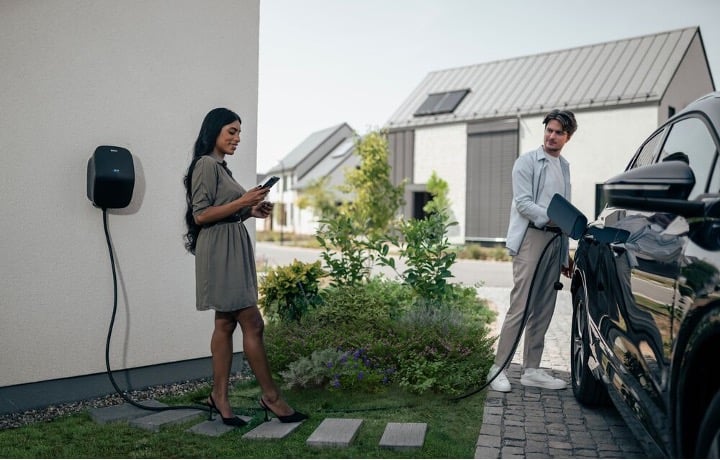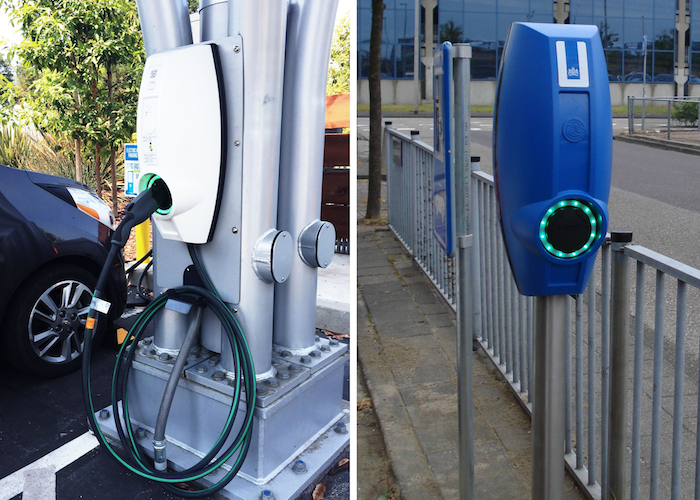
Sure, the electric vehicle has become one of the biggest disrupters to the transportation industry, but while this massive change is on the horizon, there is still a lot that needs to change in order to accommodate for it. And different places are going about it in drastically different ways.
Here, we are going to go over the five biggest ways EV driving in the United States differs from Europe.
1. Charging cables are attached
In Europe, EV drivers will carry around their own charging cable in the trunk of their car and plug it into a charging station when they need to juice up.
In the US, every charging station has its own attached charging cable. This way, there is no risk of your cable being stolen, and drivers never have to worry about accidentally being stuck without a cable.
For drivers, attached cables make life much simpler. For a station owner, however, having an attached cable means there’s one more component they need to maintain. That’s why, in the US, a good cable management system (CMS) is incredibly important — otherwise drivers will just leave the cable on the ground where it can get damaged or present a tripping hazard.
2. Most charging is privately owned
In Europe, it’s not uncommon for a city or township to provide its residents with publicly owned charging stations right on the street. That is not to say that users don’t pay for charging, but just that the stations are owned and operated by the government, and the cost of charging is more consistent.
In the US, this type of government owned charging network is largely unheard of. Certain cities are working towards implementing systems like this (i.e., Atlanta) but by and large, almost all charging stations in the US are privately owned, meaning the cost to charge is dictated solely by the owner of the station (i.e., parking garage owner).
3. Americans drive EV to save $$$
There are lots of reasons to switch to EV — to be on the technological forefront, to help reduce your carbon footprint, and the superior driving experience, to name a few.
In Europe, most EV drivers cite environmental factors as the primary reason they chose to switch. In the US, however, the main reason people opt for EV driving is a little more basic — driving EV is cheaper.
The fun thing about this distinction is, the reason why you drive EV doesn’t really matter!
So, you chose to drive an EV car because you want to be more eco-conscious? Congrats, your car is also much cheaper to operate. Wanted to stop paying high gas prices so you switched to EV? Awesome, your car is also much better for the environment, too. No matter what your motivating factor, you still reap every single benefit of driving EV. A solid choice all around.
4. Americans prefer bigger stations
In Europe, station size can be an issue. Owners and users alike prefer something with a smaller profile, so as to not take up too much space.
The US, on the other hand, seems to be totally cool with larger stations — even favoring them in many instances.
One reason could be that, since there are fewer stations available, it makes sense to install something bigger and more noticeable, making it easier for drivers to see. Another reason could be that a bigger station provides more room to potentially advertise your company’s eco-conscious image.
No matter what the cause, America is still upholding their steadfast belief that bigger = better.
5. America is much newer to the EV market
It may not feel like it, since many major EV companies are from the US (i.e., Tesla), but America is still way behind Europe in terms of overall accommodation for EV drivers.
In Europe, there are networks of charging stations all over, making it easier for EV drivers to find a charge almost anywhere they go.
In most parts of the US, however, finding publicly available charging can still be a challenge. Sure, most people charge their car at home, but for this switch to truly take off, drivers need to feel comfortable straying further from home than the ~150 miles of range their car will allow. (A condition known as "range anxiety").
On the plus side, this means that there's a lot of room to grow, and a ton of opportunities for property owners to be ahead of the curve and provide a much-needed service to a rapidly growing group of drivers. And with the help of some very lucrative incentives and rebates, drivers in many states can make the switch to EV for a whole lot less. (Seriously — these rebates are nuts!)
Now that you have a better understanding of what makes EV driving in the US unique, it’s time for you to get involved in helping expand the US charging station network. Find out how to install some charging stations of your own and be a pioneer for EV driving in the US!
Related articles

Smart Charging for Solar EV Systems: What is possible today?
There are a variety of smart solutions available, capable of optimizing your solar EV charging system in different...

Can solar EV charging save you money?
Charging your EV using household solar panels can indeed save you money on your utility bills. How much money solar EV...

How to optimize your solar set-up for charging electric cars at home
There are several ways EV drivers can optimize a homegrown solar system to ensure their EV recharging needs are met....




